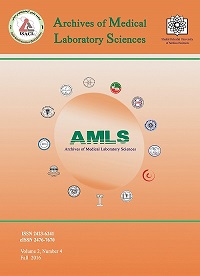The Correlation Between SMG1 Promoter Methylation and Its Expression in Acute Lymphoblastic Leukemia Patient
Archives of Medical Laboratory Sciences,
Vol. 2 No. 4 (2016),
16 April 2017
https://doi.org/10.22037/amls.v2i4.16247
Abstract
Background: Acute lymphoblastic leukemia (ALL) comprises a heterogeneous group of disorders which originate from various important genetic lesions in B and T progenitor cells, including mutations that lead to stage-specific developmental arrest and those that impart the capacity for unlimited self-renewal, resulting in clonal expansion of immature progenitor cells. Acute lymphoblastic leukaemia occurs in both children and adults but its incidence peaks between 2 and 5 years of age. Causation is multifactorial and exogenous or endogenous exposures, genetic susceptibility, and chance have roles. Survival in pediatric acute lymphoblastic leukaemia has improved to roughly 90% in trials with risk stratification by biological features of leukaemic cells and response to treatment, treatment modification based on patients' pharmacodynamics and pharmacogenomics, and improved supportive. The promoter methylation pattern of DNA in cancer cells is different with the normal cells. Suppressor with morphogenetic effect on genitalia family member (SMG1) belongs to a family of phosphoinositide 3-kinase-related kinases and is the main kinase involved in nonsense-mediated mRNA decay.
Materials and Methods: This study was performed to investigate the correlation between SMG1 promotor methylation and its expression levels in acute lymphoblastic leukemia using methylation specific PCR (MSP). Our patients and control samples were collected from Children's Medical Center of children medical center of Imam Khomeini hospital of Tehran. To confirm the MSP results, we used Quantitative Real time-PCR (qRT-PCR ) to measure the expression level of mRNA to find out if there is any relation between pattern of methylation and expression.
Results: After performing MSP, we found that SMG1 promoter was hypermethylated. Hyper methylation of SMG1 was detected in 67/74% (21/31) of ALL samples compared to control group. SMG1 mRNA expression was down- regulated 2.74 fold compared to control group.
Conclusion: The aim of this study was to investigate the effect of methylation pattern on gene expression. Our findings suggest that SMG1 acts as a functional tumor suppressor gene which was down-regulated by CpG islands hypermethylation in ALL patients. It was shown that the methylation of SMG1 was occurred in the 67/74% of samples.
- Acute lymphoblastic leukemia (ALL). SMG1
- DNA Methylation
How to Cite
References
Rocha JMC, Xavier SG, de Lima Souza ME, Assumpção JG, Murao M, de Oliveira BM. Current strategies for the detection of minimal residual disease in childhood acute lymphoblastic leukemia. Mediterranean Journal of Hematology and Infectious Diseases. 2016;8(1).
Bhojwani D, Howard SC, Pui C-H. High-risk childhood acute lymphoblastic leukemia. Clinical Lymphoma and Myeloma. 2009;9:S222-S30.
Hunger SP, Lu X, Devidas M, Camitta BM, Gaynon PS, Winick NJ, et al. Improved survival for children and adolescents with acutelymphoblastic leukemia between 1990 and 2005: a report from the children's oncology group. Journal of Clinical Oncology. 2012:JCO. 2011.37. 8018.
Bassan R, Hoelzer D. Modern therapy of acute lymphoblastic leukemia. Journal of clinical oncology. 2011;29(5):532-43.
Pieters R, Schrappe M, De Lorenzo P, Hann I, De Rossi G, Felice M, et al. A treatment protocol for infants younger than 1 year with acute lymphoblastic leukaemia (Interfant-99): an observational study and a multicentre randomised trial. The Lancet. 2007;370(9583):240-50.
Passaro D, Quang CT, Ghysdael J. Microenvironmental cues for T‐cell acute lymphoblastic leukemia development. Immunological Reviews. 2016;271(1):156-72.
Marcucci G, Yan P, Maharry K, Frankhouser D, Nicolet D, Metzeler KH, et al. Epigenetics meets genetics in acute myeloid leukemia: clinical impact of a novel seven-gene score. Journal of Clinical Oncology. 2014;32(6):548-56.
Das PM, Singal R. DNA methylation and cancer. Journal of clinical oncology. 2004;22(22):4632-42.
Taby R, Issa JPJ. Cancer epigenetics. CA: a cancer journal for clinicians. 2010;60(6):376-92.
Galm O, Herman JG, Baylin SB. The fundamental role of epigenetics in hematopoietic malignancies. Blood reviews. 2006;20(1):1-13.
Esteller M. Epigenetics in cancer. New England Journal of Medicine. 2008;358(11):1148-59.
McIlwain DR, Pan Q, Reilly PT, Elia AJ, McCracken S, Wakeham AC, et al. Smg1 is required for embryogenesis and regulates diverse genes via alternative splicing coupled to nonsense-mediated mRNA decay. Proceedings of the National Academy of Sciences. 2010;107(27):12186-91.
Janczar S, Janczar K, Pastorczak A, Harb H, Paige AJ, Zalewska-Szewczyk B, et al. The Role of Histone Protein Modifications and Mutations in Histone Modifiers in Pediatric B-Cell Progenitor Acute Lymphoblastic Leukemia. Cancers. 2017 Jan 03;9(1). PubMed PMID: 28054944. Pubmed Central PMCID: 5295773.
Villar Garea A. Epigenetic transcriptional repression of tumor suppresor genes and its reversion by drugs. 2005.
Yahui Du FL, Peng Li, Jingjing Ye, Min Ji, Daoxin Ma and Chunyan Ji. SMG1 Acts as a Novel Potential Tumor Suppressor with Epigenetic Inactivation in Acute Myeloid Leukemia. International Journal of Molecular Sciences. 2014;15:17065-76.
Wolffe APBaAP. Methylation-Induced Repression—Belts, Braces, and Chromatin. Cell. 1999;99:451–4.
Rebeiro P JA, Ling S, Caxeiro N, Lee CS, Roberts T. The role of SMG1 expression in B cell lymphoproliferative disease. Pathology. 2016;48(S1).
Uchida T, Kinoshita T, Nagai H, Nakahara Y, Saito H, Hotta T, et al. Hypermethylation of the p15INK4B gene in myelodysplastic syndromes. Blood. 1997;90(4):1403-9.
Longman D, Hug N, Keith M, Anastasaki C, Patton EE, Grimes G, et al. DHX34 and NBAS form part of an autoregulatory NMD circuit that regulates endogenous RNA targets in human cells, zebrafish and Caenorhabditis elegans. Nucleic acids research. 2013;41(17):8319-31.
Cheung H, St Jean M, Beug S, Lejmi-Mrad R, LaCasse E, Baird S, et al. SMG1 and NIK regulate apoptosis induced by Smac mimetic compounds. Cell death & disease. 2011;2(4):e146.
- Abstract Viewed: 140 times
- PDF Downloaded: 67 times
